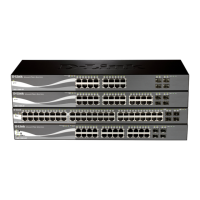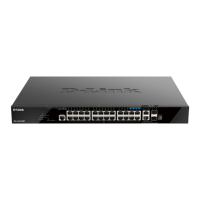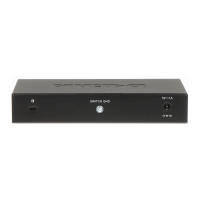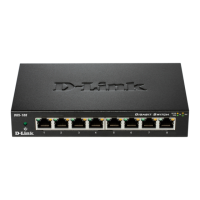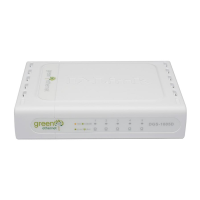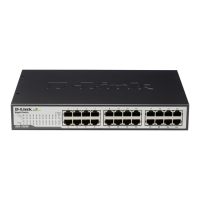DGS-1510 Series Gigabit Ethernet SmartPro Switch Web UI Reference Guide
106
of forwarding packets to the specified port list. Port cost can be set
automatically or as a metric value. The default value is 0 (auto).
Setting 0 for the external cost will automatically set the speed for
forwarding packets to the specified port(s) in the list for optimal
efficiency. The default port cost for a 100Mbps port is 200000 and the
default port cost for a Gigabit port is 20000. The lower the number, the
greater the probability the port will be chosen to forward packets.
State
Select to enable or disable the STP port state.
Guard Root
Select to enable or disable the guard root function.
Link Type Select the link type option here. Options to choose from are Auto,
P2P, and Shared. A full-duplex port is considered to have a point-to-
point (P2P) connection. On the opposite, a half-duplex port is
considered to have a Shared connection .The port cannot transit into
the forwarding state rapidly by setting the link type to Shared. By
default this option is Auto.
Port Fast Select the port fast option here. Options to choose from are Network,
Disabled, and Edge. In the Network modem the port will remain in the
non-port-fast state for three seconds. The port will change to the port-
fast state if no BPDU is received and changes to the forwarding state.
If the port received the BPDU later, it will change to the non-port-fast
state. In the Disable mode, the port will always be in the non-port-fast
state. It will always wait for the forward-time delay to change to the
forwarding state. In the Edge mode, the port will directly change to the
spanning-tree forwarding state when a link-up occurs without waiting
for the forward-time delay. If the interface receives a BPDU later, its
operation state changes to the non-port-fast state. By default, this
option is Network.
TCN Filter
Select to enable or disable the TCN filter option. Enabling TC filtering
on a port is useful for an ISP to prevent the external bridge to a core
region of the network, causing address flushing in that region, possibly
because those bridges are not under the full control of the
administrator. When a port is set to the TCN filter mode, the TC event
received by the port will be ignored. By default, this option is Disabled.
BPDU Forward
Select to enable or disable BPDU forwarding. If enabled, the received
STP BPDU will be forwarded to all VLAN member ports in the
untagged form. By default, this option is Disabled.
Priority Select the priority value here. Options to choose from are 0 to 240. By
default this option is 128. A lower value has higher priority.
Hello Time
Enter the hello time value here. This value must be between 1 and 2
seconds. This value specifies the interval that a designated port will
wait between the periodic transmissions of each configuration
message.
Click the Apply button to accept the changes made.
MST Configuration Identification
This window is used to view and configure the MST configuration identification settings. These settings
will uniquely identify a multiple spanning tree instance set on the Switch. The Switch initially possesses
one CIST, or Common Internal Spanning Tree, of which the user may modify the parameters for but
cannot change the MSTI ID for, and cannot be deleted.
To view the following window, click L2 Features > Spanning Tree > MST Configuration Identification,
as shown below:

